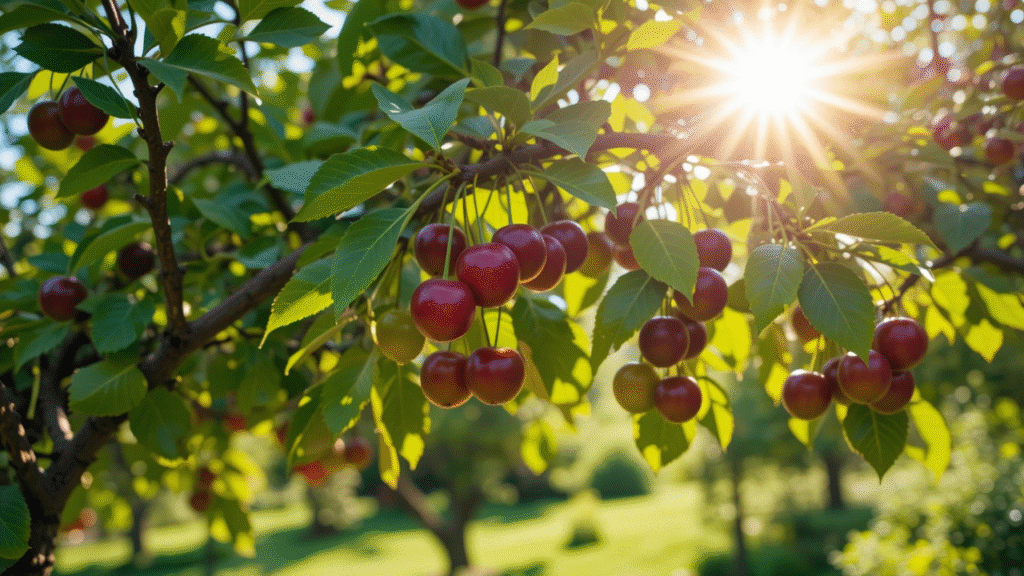
Cherry Tree Summer Care: Tips for Thriving Trees During the Hottest Months
Summer brings sunshine, sweet fruit, and—if you’re not careful—stress for your cherry trees 🌞🍒. With rising temperatures and intense heatwaves, it’s easy for even healthy trees to struggle. Cherry Tree Summer Care: Tips for Thriving Trees is more than a seasonal chore—it’s the key to protecting your trees from dehydration, pests, and fruit loss. Whether you’re growing cherries for their beauty or their bounty, a little summer TLC goes a long way. In this guide, you’ll find simple, actionable steps to help your cherry trees not just survive—but truly thrive—during the hottest months of the year.
Table of Contents
Toggle🌞 Understanding Cherry Tree Needs in Summer 🌳
Cherry trees, like us, feel the heat in summer! During the hottest months, they face unique challenges that can impact their health and fruit production. Here’s what you need to know to help them thrive:
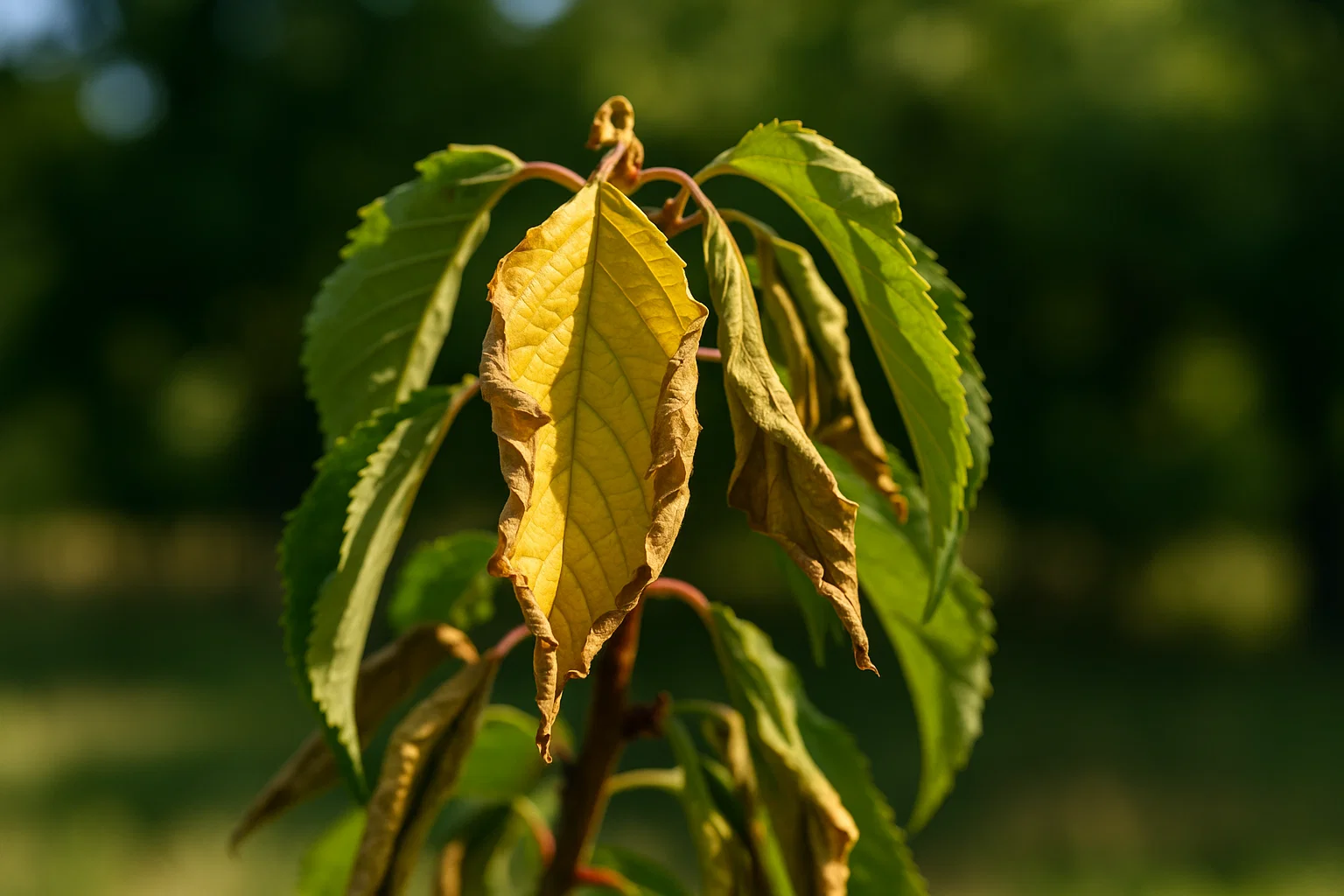
🌱 Heat Stress:
Cherry trees can become stressed in extreme heat, leading to wilting, leaf scorch, or even premature fruit drop. Keep an eye out for leaves that curl or turn yellow, which could be signs they’re struggling.
🌊 Watering:
With higher temperatures, your cherry tree’s need for water increases. A deep watering schedule (about once a week) will encourage strong, deep roots. Avoid shallow watering, as it can promote weak root growth.
🌳 Sun Exposure:
While cherry trees love the sun, too much can cause sunburn on the bark and leaves, especially young trees. Providing some light shade during peak heat can help protect them without affecting their growth.
🍒 Summer Growth:
Cherry trees are actively growing during the summer, and this is the time when they need extra energy to produce fruit and maintain healthy leaves. Ensure they’re getting the right care to support this busy growth period.
By understanding these key needs, you can give your cherry trees the best chance to flourish through summer. Stay tuned for more tips on how to keep them healthy and happy! 😊🌿
💦 Smart Watering Strategies 💦
Proper watering is essential to ensure your cherry tree stays hydrated and healthy during the hot summer months 🌞💦. Here’s how to optimize your watering routine for the best results:
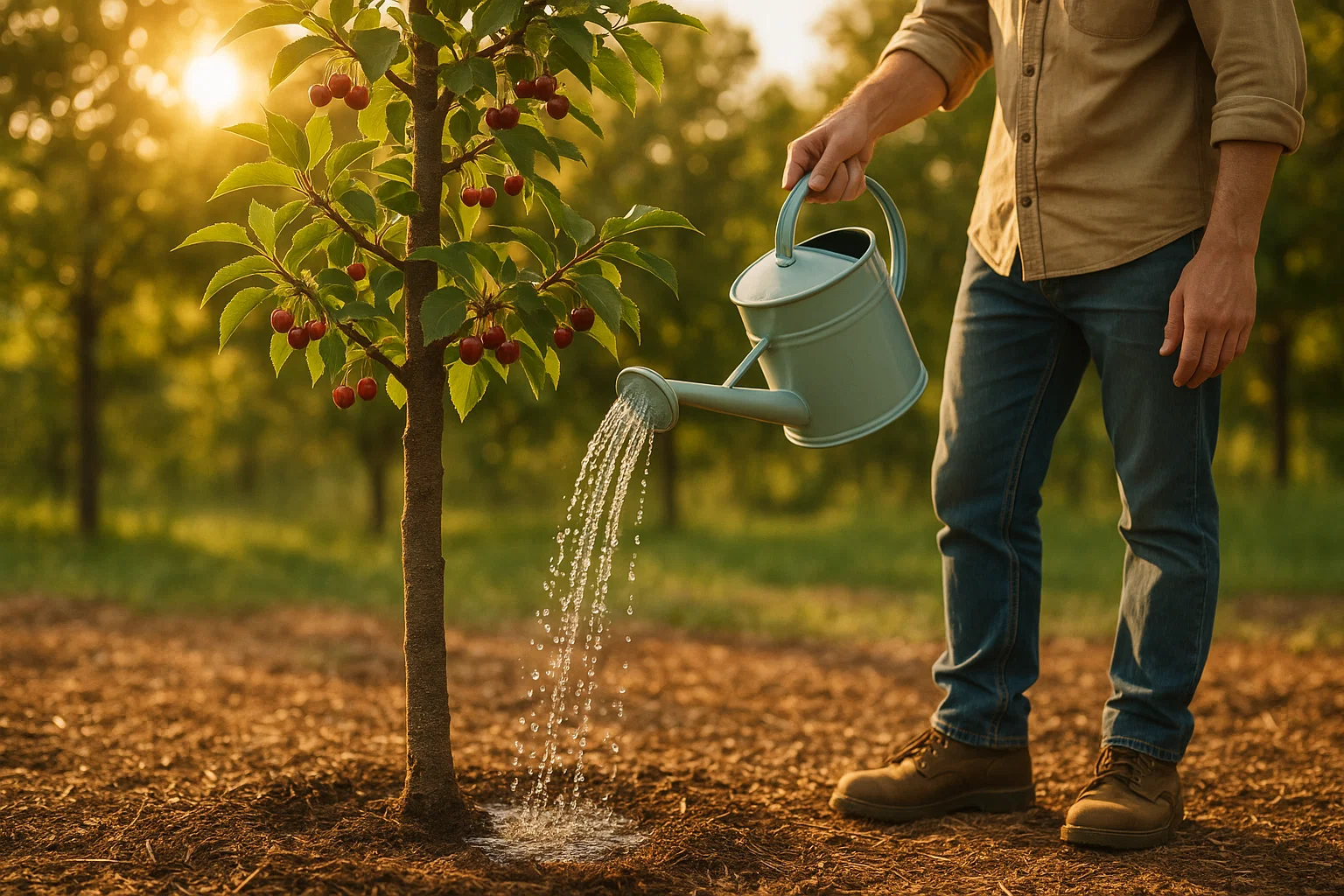
🌱 Deep Watering, Not Frequent Watering 🌱
Cherry trees benefit from deep, infrequent watering rather than frequent, shallow waterings. Watering deeply encourages the roots to grow deep into the soil, which helps the tree access moisture even during dry spells 🌿. Aim to water once a week, providing enough water to reach the root zone (around 6–8 inches deep). Shallow watering can lead to weak surface roots, which makes the tree more vulnerable to heat stress 🌞.
🌅 Water in the Morning 🌅
The best time to water your cherry tree is early in the morning 🌅. Watering at this time allows the moisture to soak into the soil before the heat of the day, reducing evaporation and ensuring the tree has enough hydration to carry it through the hottest hours 🌡️. Morning watering also minimizes the risk of fungal diseases since the leaves will have time to dry throughout the day ☀️.
🌿 Mulch to Retain Moisture 🌿
Adding a layer of mulch around the base of your cherry tree 🌳 is a simple but effective way to conserve moisture and regulate the soil temperature 🌡️. Aim for a 2–4 inch layer of organic mulch like wood chips, straw, or grass clippings 🌾. Mulch helps the soil retain moisture, reducing the need for frequent watering, and also keeps the roots cool during the scorching summer heat ☀️. Be sure to leave a small gap around the tree trunk to prevent moisture buildup and rot 🚫.
By following these smart watering strategies 💧, your cherry tree will have a strong foundation to weather the summer heat 🔥, promoting healthy growth 🌱 and ensuring a bountiful harvest 🍒. For more seasonal insights and expert advice, explore Cherry Tree Summer Care: Tips for Thriving Trees to keep your tree at its best all summer long.
🌞 Protecting from Sun and Heat 🌞
While cherry trees love sunlight, intense summer heat can be hard on them, especially during heatwaves 🌞. Here’s how to protect your tree from excessive sun exposure and heat stress:
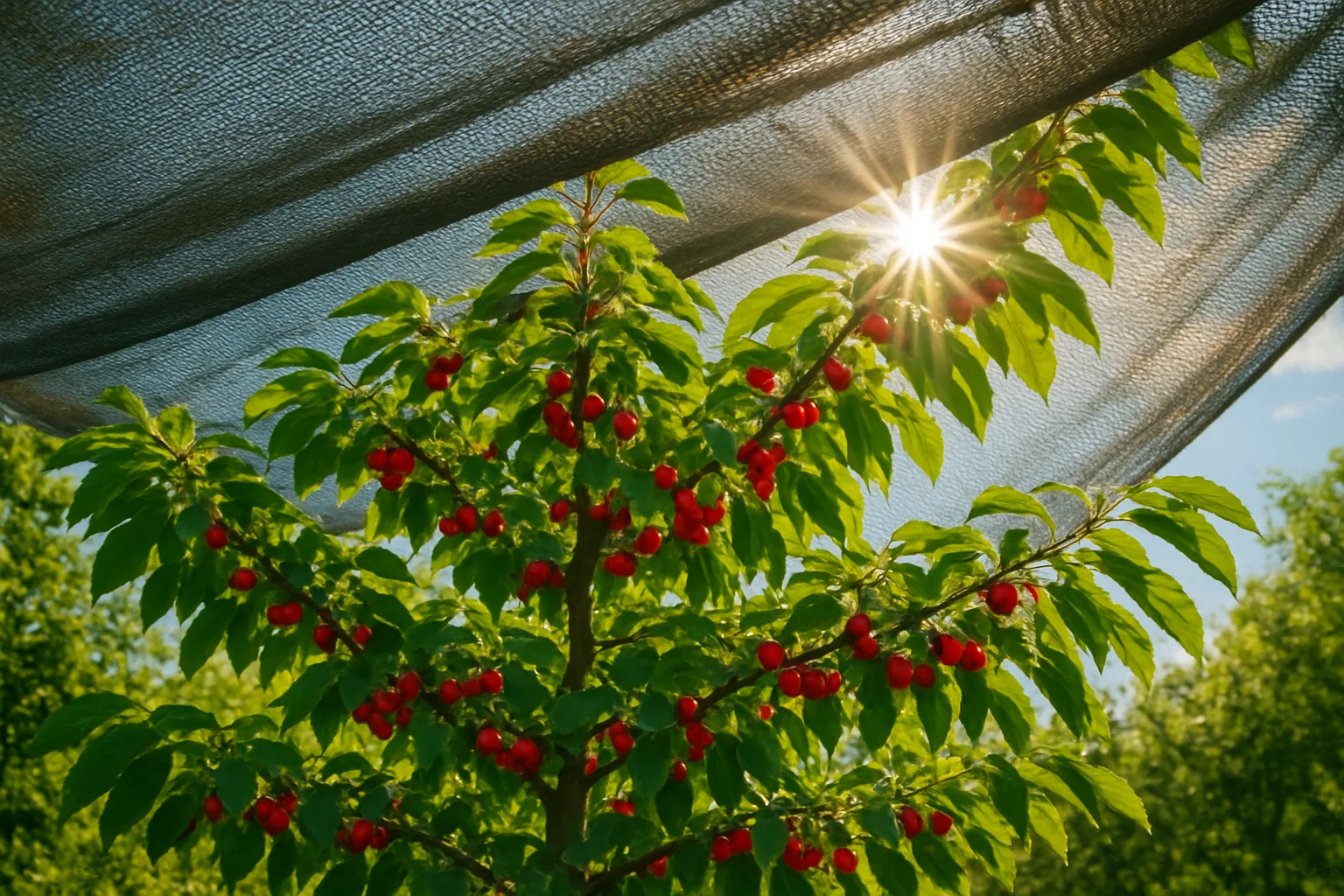
🌤️ Provide Shade During Peak Heat 🌤️
During the hottest part of the day (usually from noon to 4 p.m.), consider offering your cherry tree some light shade 🌳. You can use a shade cloth or even temporary coverings like a breathable tarp to protect it from harsh sunlight 🌞. This is especially helpful for young or newly planted trees that are more sensitive to sunburn 🌱.
🌞 Sunburn Prevention 🌞
Just like us, cherry trees can get sunburned 😣. Look out for pale or discolored bark, particularly on the trunk and young branches, which can indicate sun damage 🌿. To prevent sunburn, you can wrap the tree’s trunk with tree guards or white wrapping paper during intense sun exposure 🌳. This reflects sunlight and helps the tree stay cool 🧊.
✂️ Prune Carefully ✂️
While pruning is important for tree health 🌱, avoid heavy pruning during the summer months. Excessive pruning can expose the tree to too much sun, leading to sunburn on the tender inner branches 🌞. If you need to prune, do it early in the season before the intense summer heat arrives 🌿.
💧 Keep the Soil Moist 💧
As discussed earlier, maintaining soil moisture is critical 🌱. Dry soil can increase heat stress, so ensure your tree is adequately watered to help regulate its temperature 🌡️. Mulching, as mentioned before, is a great way to help keep the soil cool and moist during high temperatures 🌿.
By protecting your cherry tree from sun and heat ☀️, you’ll help it stay healthy, vibrant, and ready to produce delicious fruit all season long. For more ways to beat the summer stress, check out Cherry Tree Summer Care: Tips for Thriving Trees and keep your tree thriving through the hottest days. 🍒🌳.
🍒 Feeding and Fertilizing 🍒
During the summer, cherry trees are in active growth mode, needing extra nutrients to stay strong and produce delicious fruit 🍒. Here’s how to feed your tree properly without overdoing it:

🌿 Light Summer Feeding 🌿
Unlike spring, when trees are just waking up and need plenty of nutrients, summer is a time for light feeding 🌱. Excessive fertilization in hot months can stress your tree 🌞, so avoid heavy doses of fertilizer. Instead, opt for a slow-release, balanced fertilizer to provide a steady supply of nutrients over time 🌾.
🍂 Signs of Nutrient Deficiencies 🍂
If your cherry tree’s leaves are turning yellow or showing signs of poor growth, it might be lacking essential nutrients like nitrogen, iron, or potassium 🌳. In these cases, a gentle feed with a well-balanced fertilizer can help restore vitality 💪. Always check the tree for other signs of nutrient imbalance before applying any fertilizer 🧐.
🌾 Best Fertilizer Options 🌾
Organic fertilizers, such as compost or well-rotted manure, are ideal for summer feeding because they release nutrients gradually without shocking the tree’s roots 🌱. Alternatively, you can use a slow-release granular fertilizer designed for fruit trees 🍏. Just be sure to follow the manufacturer’s instructions to avoid over-fertilizing ⚖️.
🌳 Avoid Over-Fertilizing 🌳
Too much fertilizer, especially nitrogen, can cause excessive leaf growth at the expense of fruit production 🍃. This is not ideal, as your tree needs energy for both its leaves and fruit 🍒. Stick to light applications to keep your cherry tree balanced and healthy 🌿.
By feeding your cherry tree carefully and thoughtfully during the summer, you’ll support its growth, fruit production, and overall health 🌱. Just remember: moderation is key! 🌿🍒
🦠🍒 Pest and Disease Control 🦠🍒
Summer is the season when cherry trees are most vulnerable to pests and diseases 🦠🍒. Taking proactive steps can keep your tree healthy and free from harm. Here’s what you need to know:

🐜 Common Summer Pests 🐜
Several pests are attracted to cherry trees in the summer, including aphids, cherry fruit flies, and borers. 🐞 Aphids can cause leaf distortion and transmit diseases, while fruit flies target ripe cherries 🍒. Borers can damage the tree’s trunk and branches, weakening the overall health of the tree. Regularly check your tree for signs of pest damage and act early to prevent an infestation 🚫.
🌿 Natural Pest Control 🌿
Instead of using harsh chemicals, consider using organic options like neem oil or insecticidal soap, which are effective against many pests without harming beneficial insects 🦋. You can also encourage natural predators, such as ladybugs, which help keep aphid populations in check 🐞. Installing insect traps can also help reduce the number of pests in your garden. 🌳
🌧️ Fungal Diseases 🌧️
Fungal infections like powdery mildew and leaf spot thrive in humid, hot conditions 🌡️. Keep an eye out for white, powdery spots on the leaves (powdery mildew) or dark, irregular spots (leaf spot) 🌿. To prevent fungal issues, ensure your cherry tree has proper air circulation by spacing it well and avoiding overhead watering that can dampen the leaves 🌱.
🌳 Preventative Care 🌳
To keep both pests and diseases at bay, make sure your tree has strong, healthy roots and is getting proper care, such as consistent watering and balanced fertilization 🌱. Prune away any dead or damaged wood to improve air circulation, and remove fallen leaves or fruit that may harbor pests 🍂.
With regular monitoring and natural pest control methods, your cherry tree can stay safe from harmful insects and diseases, ensuring it remains healthy and productive throughout the summer 🍒🌳.
🍒 Supporting Fruit Development 🍒
Summer is when your cherry tree’s fruits start to develop, and proper care is essential to ensure they grow healthy and delicious 🍒. Here’s how to support your tree’s fruit development:
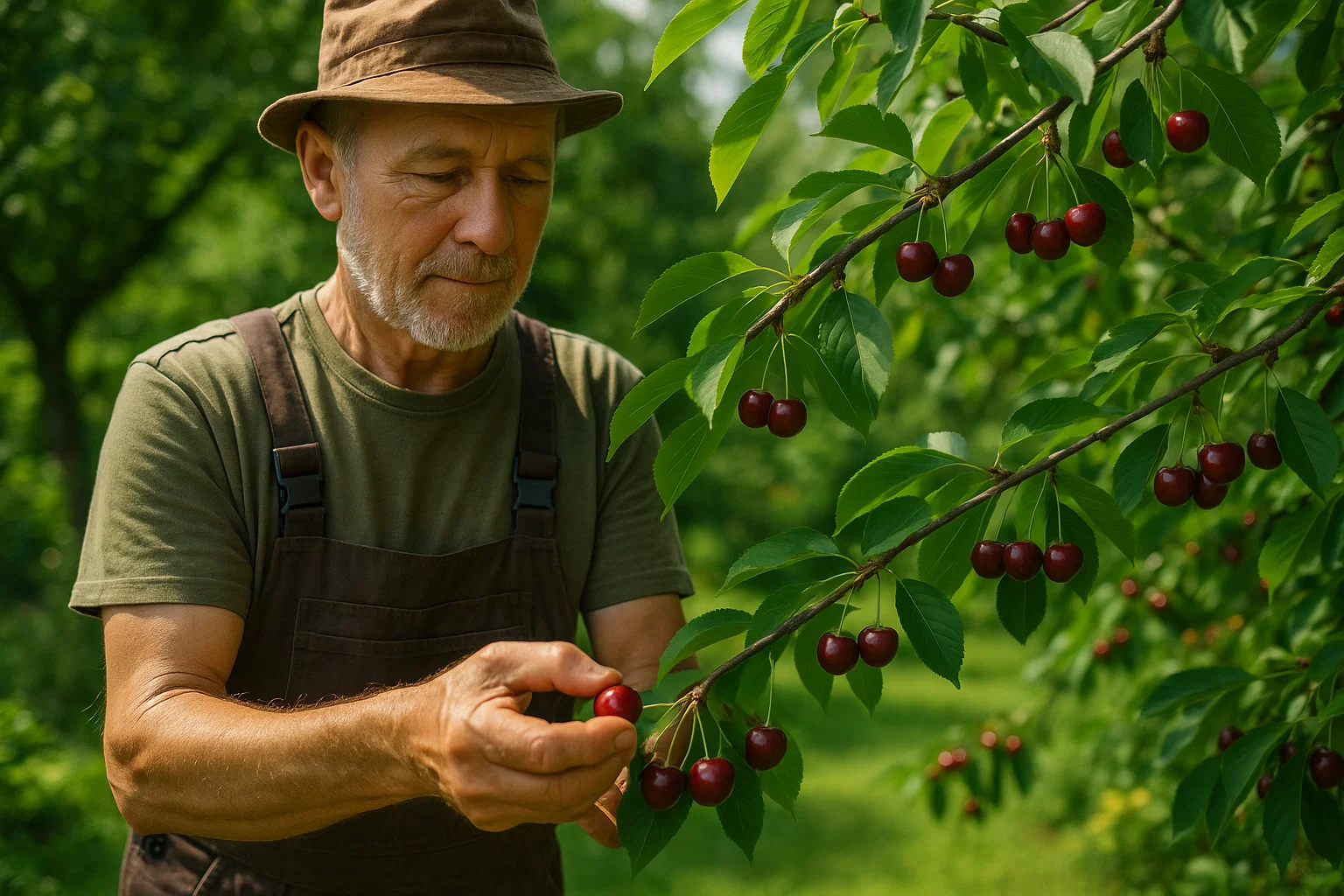
🌳✨ Thinning Fruits 🌳✨
While it might be tempting to let every cherry grow, thinning is important for better fruit quality. If your tree has a heavy fruit set, remove some of the smaller or less-developed cherries to reduce the strain on the tree. This will allow the remaining fruit to grow larger and healthier 🌳✨. Aim for about 6–8 inches between each fruit cluster to give them room to thrive.
💧🍒 Maintain Water and Nutrient Balance 💧🍒
Cherry trees need consistent hydration and nutrients during fruit development. Keep up with your watering schedule to avoid stress, and provide light feeding if needed (as mentioned in the feeding section). Well-hydrated trees with balanced nutrients will produce sweeter, juicier fruit 💧🍒.
🌞 Protecting from Excessive Heat 🌞
Hot weather can cause cherries to drop prematurely or lead to sunburn on the fruit 🍒. To protect them, ensure the tree gets some afternoon shade during extreme heat, as mentioned in the sun and heat protection section 🌤️. Keeping the soil moist and applying mulch around the base will also help keep the fruit cool and prevent stress.
🍒 Gentle Harvesting 🍒
When your cherries are ready to pick, do so gently to avoid damaging the tree or the fruit. Harvest early in the morning when the fruit is cool and firm 🍒. Use a gentle twisting motion to remove the cherries without pulling on the branches.
Supporting your cherry tree through its fruiting stage will help you enjoy a bountiful harvest. With the right care, your tree will reward you with healthy, delicious cherries all summer long. For expert seasonal guidance, explore Cherry Tree Summer Care: Tips for Thriving Trees to ensure your tree thrives during the hottest months.🌿🍒.
🛠️🌳 General Maintenance and Monitoring 🌳🛠️
Ongoing maintenance and monitoring throughout the summer are essential to keep your cherry tree healthy and thriving 🍒. Regular checks and small adjustments can help you avoid problems before they escalate. Here’s how to maintain your tree effectively:
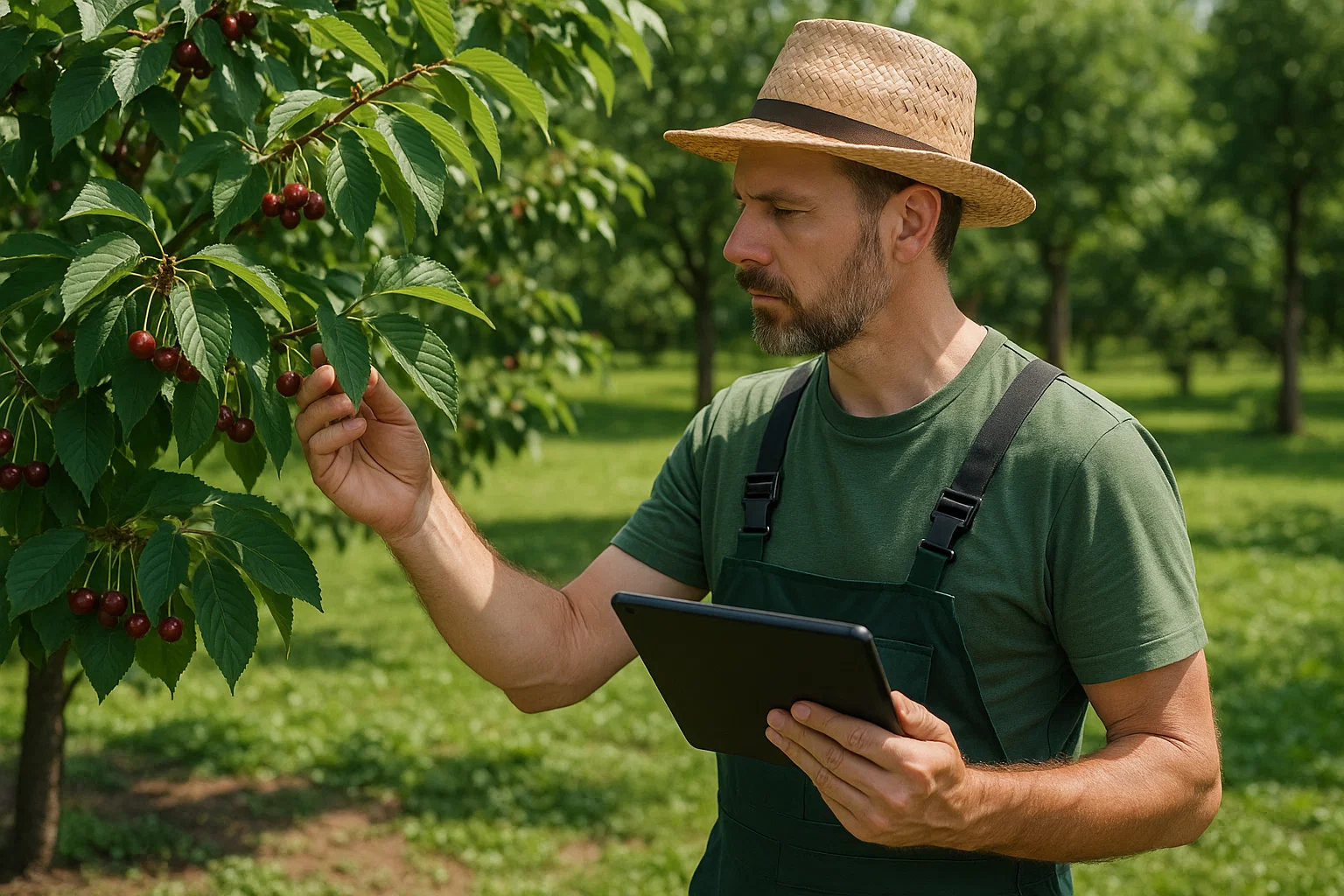
🌱 Regular Inspections 🌱
Check your tree weekly for signs of pests, diseases, or environmental stress. Look for discolored leaves, wilting, or unusual growth patterns. Early detection is key to preventing problems from becoming serious 🌿.
🧹 Pruning and Deadwood Removal 🧹
Remove any dead or diseased branches to promote healthy growth and improve air circulation. 🌬️ This also helps reduce the risk of fungal infections, which are common during hot, humid months. Be sure to prune early in the summer before the tree starts to produce fruit to avoid disrupting the fruiting process.
💧 Consistent Watering 💧
As discussed earlier, keeping your cherry tree well-watered is vital, especially during dry spells. Deep watering ensures the roots stay hydrated, even in high heat. Check the soil moisture regularly and adjust watering as needed 🌊.
🍂 Mulch Maintenance 🍂
Mulch helps retain moisture, suppresses weeds, and regulates soil temperature. Check the mulch layer periodically to ensure it’s still intact and at the proper depth (2-4 inches). Add more mulch if it has decomposed or been disturbed 🪴.
🌤️ Environmental Stress Monitoring 🌤️
Keep an eye on the weather and adjust your care routine accordingly. For example, during heatwaves, increase watering and ensure your tree is shaded during peak heat hours. 🌞 Alternatively, during periods of excessive rain, make sure your tree’s drainage is adequate to avoid waterlogging.
By staying on top of general maintenance and monitoring, you’ll give your cherry tree the best chance to stay healthy and productive throughout the summer. For a complete seasonal care routine, check out Cherry Tree Summer Care: Tips for Thriving Trees and keep your tree flourishing all summer long. 🌳🍒.
🌿🍒 Final Thoughts 🍒🌿
Caring for your cherry tree during the hot summer months doesn’t have to be complicated. By understanding its needs—whether it’s proper watering, protection from the heat, or pest control—you’re setting your tree up for a season of healthy growth and abundant fruit 🍒🌳.
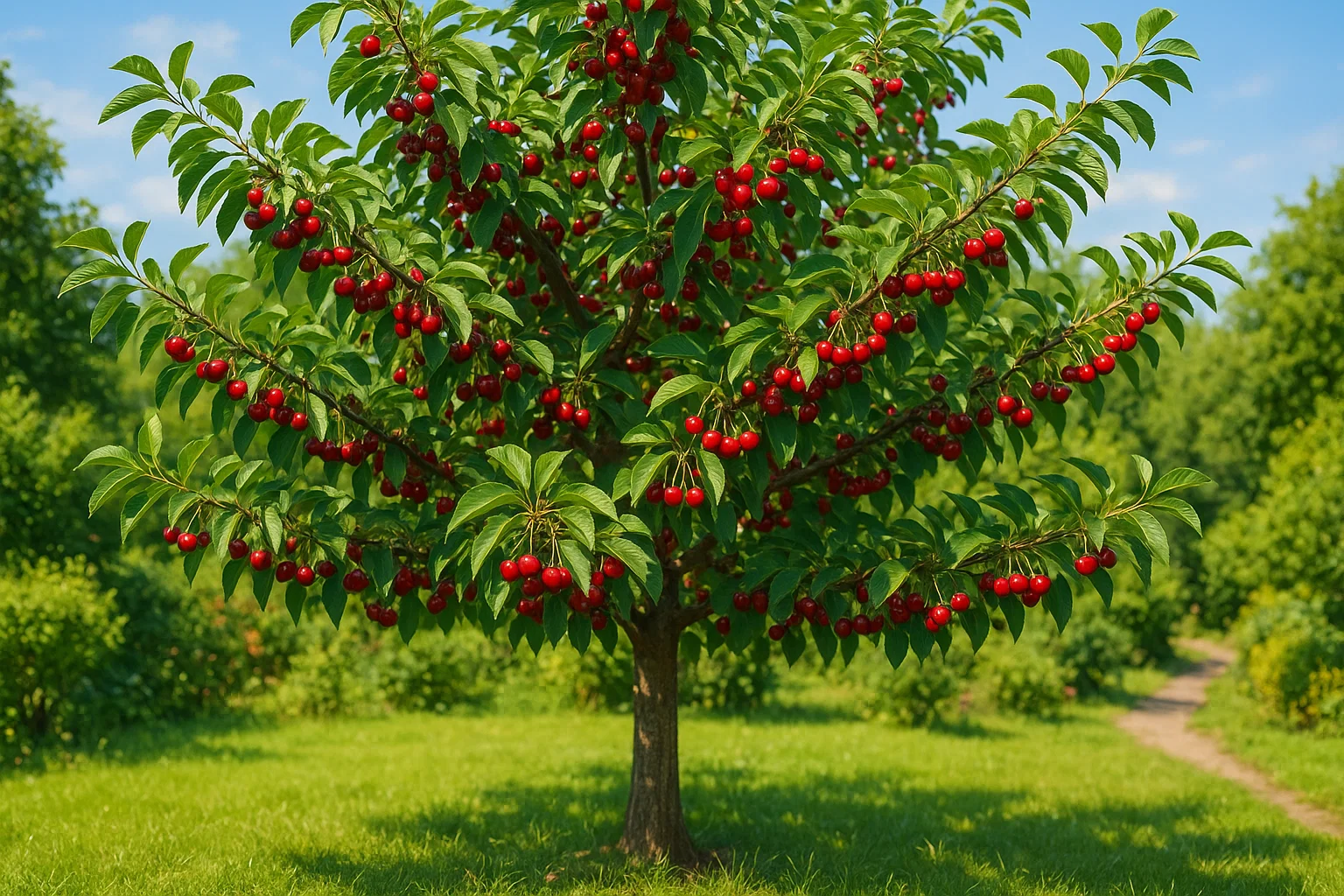
Remember, consistency is key. Check on your tree regularly, keep an eye out for any signs of stress, and take action early to prevent problems. With a little TLC, your cherry tree will thrive through the summer, rewarding you with a vibrant, fruitful harvest. 🌞🍒
So go ahead, enjoy the process of nurturing your tree, and watch it flourish! 🌿💚
Frequently Asked Questions (FAQ)
How often should I water cherry trees during summer?
Water deeply once or twice a week, depending on soil type and weather. Sandy soils may need more frequent watering.
What are signs of heat stress in cherry trees?
Wilting leaves, scorched leaf edges, and premature fruit drop are common signs of heat stress in cherry trees.
Can I fertilize cherry trees in the summer?
Light fertilizing is okay in early summer. Avoid high-nitrogen fertilizers later in the season to prevent excessive growth.
Should I mulch cherry trees in hot weather?
Yes, applying 2–3 inches of mulch helps retain soil moisture, regulate temperature, and prevent weed competition.
How can I protect cherry trees from sunburn?
Use tree wraps or shade cloth for young trees, and avoid pruning that exposes branches to direct sun in extreme heat.
Is pruning recommended in summer?
Light pruning to remove dead or diseased wood is fine. Major pruning is best done in late winter or early spring.
How do I deal with pests that appear in summer?
Monitor for aphids, mites, and caterpillars. Use neem oil or insecticidal soap for organic control.
Can cherry trees still grow fruit well in extreme heat?
Yes, if properly watered and maintained. Heat stress can affect quality, so consistent care is key.
